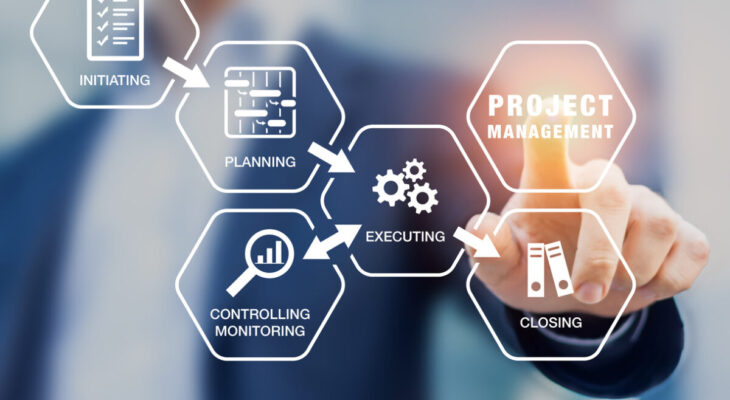Project management has become a critical part of successful construction projects and processes. An effective management approach helps to keep projects on schedule, within budget, and in compliance with quality standards.
It also assists in improving the overall team efficiency, communication, oversight, and performance during the course of the project. However, it is important to manage construction projects effectively in order to maximize their positive results.
1. Understanding The Principles

A well-defined plan of action will help ensure that each step of the project is executed in a timely manner and with the highest degree of efficiency. Careful consideration should go into creating project schedules that include both long-term and short-term goals.
Construction projects require funds for materials, labor costs, licenses, equipment rental, and other necessities. Working with a cost estimator can be beneficial in controlling these costs during the project life cycle.
Quality assurance is an important component of any construction project — ensuring that all aspects of the project are completed according to specifications and industry standards within budget and on schedule. Quality assurance covers an array of tasks such as testing equipment installation, inspecting materials, and supervising crew activities to uphold quality requirements.
Appropriately allocating resources is essential for efficiently executing construction projects on time and under budget — this requires accurate tracking tools for connecting worker performance with actual consumption rates for materials or services used in the build process. It also involves proper utilization of available machines or tools onsite including maintaining their maintenance records up-to-date to minimize downtime on tasks related to daily activities and onsite operations
2. Establishing Clear Goals and Objectives
The first step towards ensuring a successful project is setting clear objectives and goals. Constructing a building can be a complex process, but by setting specific goals and objectives, you provide yourself and all involved in the project with clarity about what success looks like. It is important that you make sure each goal is realistic, measurable, and achievable so that progress can be regularly tracked and assessed.
Having well-defined goals also helps to ensure everybody on the project understands the function of their own tasks. Additionally, it gives you a framework for developing a timeline that outlines when the various stages of construction should take place, along with assigning resources to complete tasks promptly while staying within budget.
3. Developing an Effective Plan

A plan defines the scope, roles, responsibilities, and timeline for completing each task. It also helps to coordinate all involved parties to ensure that tasks are completed on time and with accuracy.
When creating a plan, the most important things to consider are the following:
- Objectives: Outlining and setting clear objectives that everyone involved can understand will help to ensure everyone is working towards a common goal.
- Timeline: Establishing deadlines for key milestones within the project helps ensure that tasks remain on track.
- Roles & responsibilities: Assigning roles and responsibilities to members of your team will help define who is responsible for certain tasks.
- Resources: Identifying resources such as personnel, financial resources, equipment, and materials needed from internal or external sources enables you to ensure you have everything necessary for the successful completion of the project.
- Delivery & completion: Establishing a timeline for delivery and completion will help ensure that all deliverables are provided as expected.
Having an effective plan in place can provide significant benefits when it comes to managing construction projects effectively. It provides greater clarity and transparency while helping teams stay organized throughout various stages of development. An effective plan in place reduces the chances of delays or miscommunication while ultimately increasing your chances of producing successful projects on schedule.
4. Managing Resources and Budgets
Set realistic goals for what you want out of the project in terms of cost and timeline, taking into account any foreseeable influences that could affect those goals such as market changes or unforeseen events. Research resources available and compare prices to ensure you get value for money when making purchases. It may also be beneficial to plan a bit extra in your pre-project budget concerning unexpected expenses – this provides you with enough room so potential costs won’t sink your whole operation should something go wrong.
In addition, consider ways that you can use technology to help streamline processes necessary for resource and budget management such as material ordering or tracking progress against specific milestones in the timeline. Using an external accounting service can save you time and nerves, eliminating the need to deal with it yourself. Jonas Premier is definitely worth checking out. Also make sure that you are seeking advice from those who have experience handling projects similar to yours when making decisions about which vendors, subcontractors, or suppliers best fit what you need from them. This can help ensure quality outcomes at a reasonable cost are achieved efficiently throughout the life of a construction project.
5. Monitoring and Controlling

The monitoring and controlling phase of a construction project are important in ensuring that it runs smoothly, meets customer objectives, and comes in on time, on budget, and to the required quality specifications. To effectively monitor and control a project, construction managers must accurately track progress against schedule, identify risks early and take corrective action where possible.
It breaks down into three steps: tracking progress regularly against task deadlines; comparing actual results to planned performance, and managing changes as they arise. Relevant data should be collected frequently via close task-level observation. This information is used to identify any discrepancies between the plan vs reality as early as possible.
The controlling element of this phase is all about rectifying these issues as quickly as possible before they affect the overall project timeline or budget. It begins with problem identification – such as deviations from requirements or cost estimates – followed by risk analysis in order to create a plan for responding to them efficiently. The focus here is both on preventing problems from occurring again (in the case of repeat offenders) and mitigating risks from arising in the first place (based on past experiences). In some cases, it may also involve deploying additional resources or adjusting budgets accordingly.
Conclusion
Improving your construction project management processes can make a significant impact on the success of your project. By following some simple steps, you can streamline your process and ensure that everything goes as planned. By taking the time to improve these processes, you will not only create a better-finished product but also save yourself time and money in the long run.




